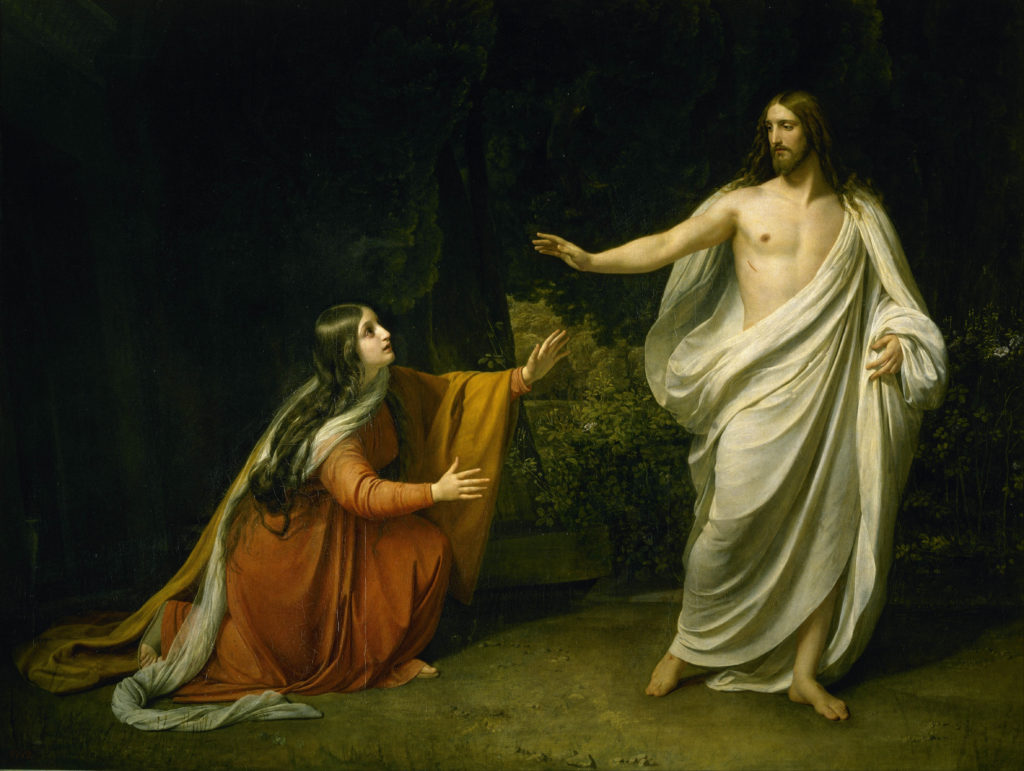“In the Garden” is a popular Protestant hymn penned by American songwriter C. Austin Miles on a rainy day in April 1912. Since its composition the hymn has appeared in over two hundred Christian songbooks (or hymnals). “In the Garden” begins,
I come to the garden alone, While the dew is still on the roses.
The power of that famous opening line is eclipsed only by the refrain:
And He walks with me, and He talks with me, and He tells me I am His own,
And the joy we share as we tarry there, None other has ever known.
The “He” in question is Jesus Christ, and the hymn offers a queer scene of extraordinary familiarity, sensuous intimacy, and trust between Lord and believer.

One might ask, “What exactly is queer about an imagined stroll with Christ and a deep personal relationship with Him?” Intimate or erotic language about God appears throughout the Christian Bible, both in the Hebrew scriptures and the New Testament writings. In the Hebrew Bible, the Song of Songs is full of erotic descriptions of lover and beloved, all of which are allegories about the relationship between God and Israel. Christians have taken the allegory also to be a foreshadowing of Christ and the Church. In the New Testament, one of the most striking metaphors is that of the Church as bride and Christ as bridegroom. Christians have incorporated such biblical imagery into centuries of liturgical and devotional tradition. However, these ideas alone are not necessarily queer. They can just as easily reinforce dominant ideas about gender and sexuality. Instead, queerness comes when holy desire and divine intimacy are able to destabilize our understandings of God and Christian alike.
Queer theorist Michael Warner remembered vividly the experience of singing “In the Garden” in his childhood church: “I would look around to make sure no one noticed that these words were coming, rather too pleasurably, from my mouth. Jesus was my first boyfriend. He loved me, personally, and he told me I was his own.” While Christian orthodoxy declares Christ to be fully human and fully divine, particulars such as gender and sexuality can be more elusive. Although gendered with male pronouns, Christ has often been understood or depicted in androgynous ways. This indeterminacy can allow for great flexibility in devotional embraces of the Incarnate God. As singers or listeners “come to the garden alone,” they enter a space where worshippers of any gender or sexual identity have the opportunity to encounter Jesus Christ as a lover who defies rigid characterization.
“In the Garden” is especially popular among evangelical Protestants for whom the ordinary acts of Sunday worship are an opportunity to celebrate prized personal relationships with Christ. However, the performance of the hymn presents an ironic, even paradoxical, situation. Christ simultaneously offers an exclusive bond with each individual beloved and a limitless capacity for welcoming new beloved into the fold. In the act of collective singing or listening, worshippers are first embracing the joy that “none other has ever known,” unique and peculiar to each believer. Yet, at the same time, they are celebrating their collective identity as the multitudinous beloved body of the almighty lover. The chaste messiah is also the polyamorous lover of the redeemed.
When C. Austin Miles composed the hymn, he based it on his favorite scriptural passage: John 20:14-16. These verses describe a scene that is unique among the four Gospels. In all four accounts, women disciples find the empty tomb of Jesus on the Sunday morning after the crucifixion. An angelic messenger commands them to spread the word of the resurrection. Only the Gospel of John includes a later meeting between Christ and one of the women disciples, Mary Magdalene. She stays behind after everyone has come and gone. Once she is alone, Jesus appears. At first, she thinks he is the caretaker of the garden that surrounds the tombs. When he calls to her by name, she recognizes him and cries “Teacher!” but is unable to hold on to him in his resurrected form.
C. Austin Miles later described the composition of “In the Garden” as the result of his own startling encounter (a reminiscence collected in hymn anthologies such as this one). On that fateful April afternoon, “I rested my hands on the open Bible, as I stared at the light blue wall. As the light faded, I seemed to be standing at the entrance of a garden.” Miles then reported a lifelike experience in which he witnessed the scene from John as though he were present. When it was over, Miles became aware of his immediate surroundings: “I awakened in sunlight, gripping my Bible with my muscles tense, and nerves vibrating, under the inspiration of the Holy Spirit. I wrote as quickly as the words could be formed the lyrics exactly as it is sung today.” In the extraordinary intensity of this moment, Miles modeled the very kind of experience that his hymn is supposed to encourage.
Unfortunately for Mary Magdalene, however, she does not appear by name in the lyrics. Depending on the hymnal, the scriptural citation from John may or may not be listed at the top of the page. While C. Austin Miles was a third party observing the garden encounter, the singer or listener may unwittingly take over the perspective of Mary Magdalene for an imagined tryst with the risen Christ. She disappears into the personal narratives forming in the minds, and coming from the tongues, of believers. It is a conspicuous absence, but perhaps it is in keeping with the gospel account. The women who arrived at the empty tomb were supposed to start their mission by finding the apostles, the all-male cadre of chief disciples. They were the first to act as bearers of revelation but also the first to become sidelined.
The historical circumstances surrounding the composition of “In the Garden” are worth noting. C. Austin Miles was a conservative Protestant who lived through the Modernist and Fundamentalist debates in early twentieth-century America. He sided with the latter group, as evidenced in the foreword to his 1900 novel About My Father’s Business: “It is the hope of the true followers of Christ that the Clergy will stop all theological controversies, the discussion of higher criticism, and the playing into the hands of the social and soup kitchen element.” These comments are a reference to the liberal Protestant supporters of the historical-critical method of biblical study (“higher criticism”) and the progressive agenda known as the Social Gospel (“social and soup kitchen element”). Miles and fellow Fundamentalists opted for a doctrine of biblical inerrancy and saw the Social Gospel as a deviation from the church’s evangelistic responsibilities.
Is my queer reading of this hymn an attempt to find some erotic subtext planted by a repressed C. Austin Miles and sung by unwitting evangelical Christians? No, it is most certainly not. Rather, “In the Garden” demonstrates the ways in which a queer approach to Christian hymns can reveal the surprising complexities of liturgical and devotional practice. In fact, this particular hymn is intriguing precisely because of its popularity in more theologically conservative traditions. Queer theorists have shown that queerness is not necessarily confrontational or oppositional. It can exist within the dominant practices and ideas of communities that are heteronormative or otherwise hegemonic. The figure of Christ and the nature of Christian devotion do not have to fall into binaries of conservative and liberal. There is a strong temptation to treat Christianity in broad, reductionist strokes, especially regarding matters of gender and sexuality. I hope to add to the voices calling for more attention to the queer possibilities of Christian thought and practice. As religious scholar Mark D. Jordan has observed, “Queer theorists have trouble paying enough attention to queer religion—especially if the religion is Christian and the theorists Anglo-American.” I humbly offer the case of “In the Garden” as an example of a hymn so often sung as to be unremarkable and yet packed with astonishing interpretive possibilities as it praises a polyamorous Christ.
 Chris Fite is a PhD student in History and Sociology of Science at the University of Pennsylvania, as well as a candidate for the Graduate Certificate in Gender, Sexuality, and Women’s Studies. He currently serves as a Graduate Fellow at the Collegium Institute for Catholic Thought and Culture. Chris works on the history of science and religion in the patristic period, drawing on scholarship in the history of science, religious studies, queer theory, and postcolonial studies.
Chris Fite is a PhD student in History and Sociology of Science at the University of Pennsylvania, as well as a candidate for the Graduate Certificate in Gender, Sexuality, and Women’s Studies. He currently serves as a Graduate Fellow at the Collegium Institute for Catholic Thought and Culture. Chris works on the history of science and religion in the patristic period, drawing on scholarship in the history of science, religious studies, queer theory, and postcolonial studies.
NOTCHES: (re)marks on the history of sexuality is licensed under a Creative Commons Attribution-NonCommercial-NoDerivatives 4.0 International License.
Based on a work at www.notchesblog.com.
For permission to publish any NOTCHES post in whole or in part please contact the editors at NotchesBlog@gmail.com





Chris, I really really appreciate your insights, and they make so much sense to me. I have always felt that God is everything so of course He encompasses all genders or no genders and beyond gender – he is all!